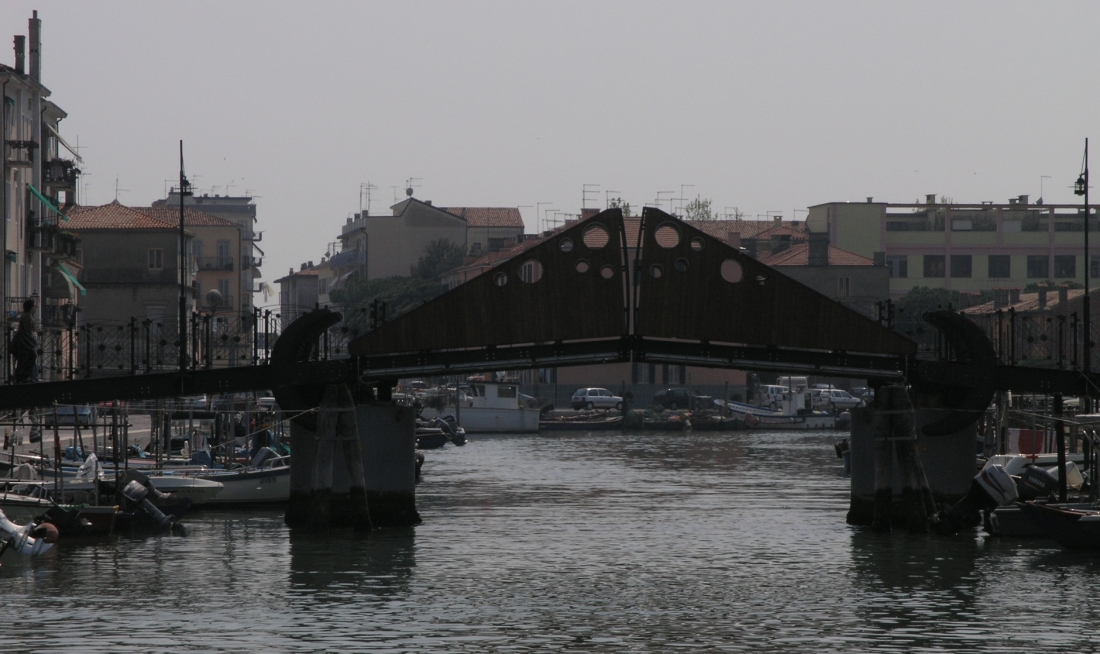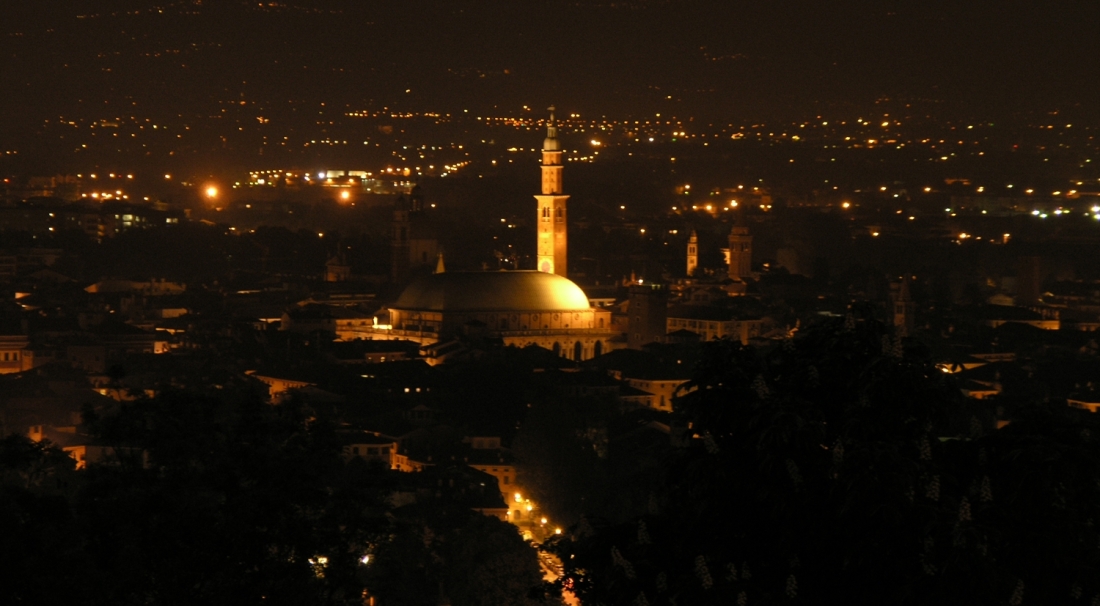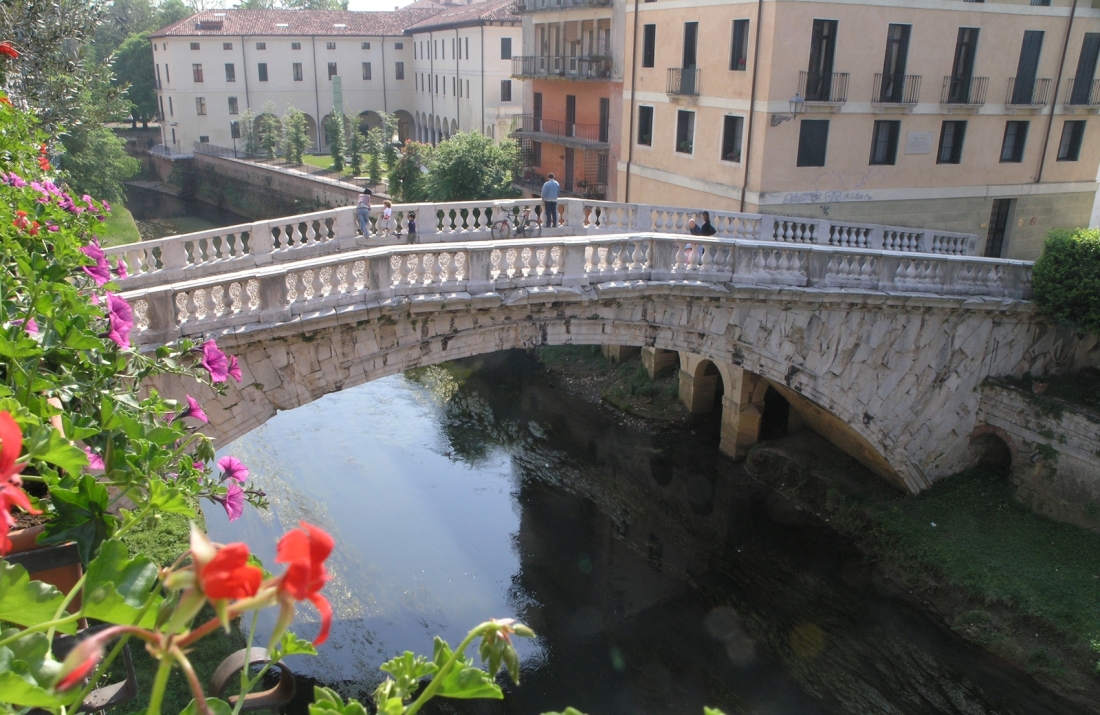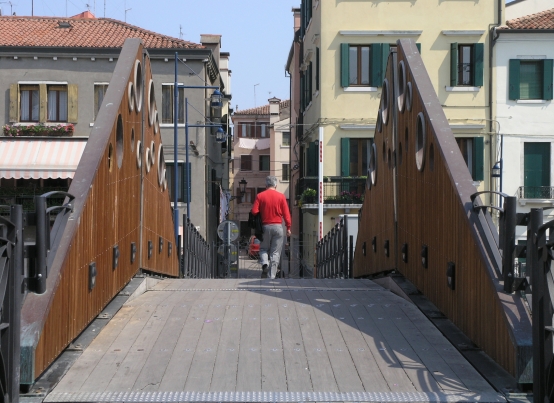5.5. Leaving Florence
It was 20:25 and we had a long drive to Cesena and our HospitalityClub friend GianCarlo. The shortest road (which Giancy had recommended instead of the highway via Bologna, ”badly jammed by trucks” which would have been 80 km) was 130 km and that was supposed to take 2-2,5 hours. Well – the route consisted mainly of serpentine roads with hundreds and hundreds of curves, every second one being so sharp that an unaccustomed driver had to switch down to 2nd. And it was pitch-dark most of the time. One soon learned a suitable rhythm – accelerate, brake, accelerate, break – but it was rather exhausting after a couple of hours – luckily there were some ”normal” parts in the valleys once in a while. We thought it was no wonder that Italian Massimo Biassion had been such a good rally driver having trained in such roads… But eventually we were in Cesena. Which was a bigger city than we had thought. We stopped to ask for advice from the customers of a pub. And followed a couple of them who were just leaving with their car. Luckily we were already almost ”behind the corner”.
There was no light in Giancy´s windows. We had tried to phone him 2-3 times as we were driving but in vain – no answer. Perhaps he didn´t want to answer… We were prepared to sleep in the car which would have been quite difficult. Beside the gate in front of the house there were two door phones. We pushed a button – and heard a friendly voice answering: ”Well hello! Please wait a second, I put something on before coming to open the gate…” It turned out that he had forgot his cell phone on silent mode and hadn´t heard our calls! We got a very warm and hearty welcoming. After chatting a while over teacups we got to sleep in Giancy´s own double-bed, Teemu on a sofa. We wondered a little about where GianCarlo himself slept. In the morning we knew: he had slept on the floor on a mattress…
Saturday 6.5. Chioggia – “Little Venice”
In the morning we should´ve gone off early but we had such a good time (and had come so late in the evening) that we started the car at about 10.50. Cesena was anyway just a stopover on the route to Venice. Our next target was however – largely inspired by Giancy´s suggestions – Chioggia, or ”Little Venice”. It´s situated by the sea 140 km north of Cesena and 55 km south of Venice. It´s actually in the southern end of the same laguna as Venice is in the northern part of. The distance to Venice is only 25 km by water. Chioggia is indeed very charming and, what was the most important, there are several bridges… Most of them are old but they are largely very similar and not very original. The most interesting of them was the newest one. It looked quite new and connects the old town to a newer part, the former cement factory area over Canal Lombardo. It was made of wood and steel and seemed like someone really had put an effort in its design. We couldn´t manage to find out its official name but the Chioggians call it “Ponte de Fero”, Iron bridge. It is a bascule bridge (lift bridge) in order not to prevent the vivid boat traffic too much (Chioggia is one of the biggest fishing ports in the Adriatic sea and the water traffic is otherwise busy there, too). 
Still there was perhaps an even more powerful bridge there – just on the end of both the lagoon and Canal Vene slicing the old town in two – the Ponte Vigo. It forms a balcony to the sea for the citizens of this town. This bridge is quite overwhelming compared to the other seven bridges in the canal. It was built in 1685 ordered by mayor Morosini to replace the former wooden bridge, the fire safety of which was considered poor. Originally the bridge was made of brick like the other bridges in the canal but the cladding and statues of Isthrian marble were added in 1762. In this place there had been a wooden bridge at least already in 1379-80 during the war of Chioggia. As a result of this war between Venice and Genoa, Venice won control over Mediterranean commerce.  The lion statues, though impressing, are so small in the eyes of Venetians that they call them ”pussycats”. When we examined our photos afterwards we saw that the lions hold with one front paw a rounded stone tablet with three short lines of text. Unfortunately the tablets aren´t to be seen so sharply in the pictures that one could read them. In the middle parts of the facades there are reliefs portraying Virgin Mary and patron saints of the city, San Felice and S. Fortunato.
The lion statues, though impressing, are so small in the eyes of Venetians that they call them ”pussycats”. When we examined our photos afterwards we saw that the lions hold with one front paw a rounded stone tablet with three short lines of text. Unfortunately the tablets aren´t to be seen so sharply in the pictures that one could read them. In the middle parts of the facades there are reliefs portraying Virgin Mary and patron saints of the city, San Felice and S. Fortunato.
Inside the parapets there are stone benches for the citizens to sit. And yes, on a clear day you can see even Venice reasonably well. Before the time of electric light there has been also a lighthouse or a beacon in the middle of the bridge to guide the seafarers.
We´d also like to mention that the bell tower of nearby Sant´Andrea church is hundreds of years older than the church itself, from 11th or 12th century. The bell is said to be the oldest tower bell in the world – who knows?
We were back by the car at 16 O´Clock after an ice cream break (it was torridly hot at least after coming from Finland´s spring, 28 degrees Celsius if not more) and drove on a while. Our original plan was to visit Venice next but because: 1) it was still hot and we were rather exhausted after the day before and lack of sleep and 2) Now that we had reached the nearness of Venice and eaten it was clear that after Venice we would again be hopelessly late at our next host couple. They had told we could stay there two nights and visit Venice in between. We decided to grab the bait even if it would ”destroy” our schedule. It would be wise to restore our strength for the rest of the trip…
We had still 70 km left to Vicenza via Padua, again largely on a regional road beside the highway. In Vicenza we had to ask for advice before a roundabout to be able to choose the right direction. Partly because the signing (and of course the whole environment) is slightly different and has a different logic than we were used to. Anyway now at the latest it was evident that even a very limited vocabulary – just a few words – of local language helps surprisingly much. And in this specific case it was utmost useful that we had seen Dario´s and Roberta´s house beforehand in GoogleEarth´s aerial view. Namely, the house is not seen from the street and there´s no sign or number showing its existence… But well, now we were there and again getting acquainted with people we had been in an intense e-mail contact with.

- Vicenza by night – Palladio´s Basilica in the middle
Late at night Roberta, Dario, Roberta´s sister and her husband Diego hosted a stroll in the historical old town of Vicenza which has excellently survived its medieval and renassaince look. Vicenza, apart of being a wealthy city of gold and jewellery business, also Città Palladiana, listed as a Unesco World Heritage site mainly because of the works (23 in all) of architect Andrea Palladio (1508-80). There´s also a research there, Centro Internazionale di Studi di Architettura Andrea Palladio.
The great master condensed his experience and theories in a book published in 1570, I quattro libri dell´arquitettura, Four Books on Architecture, which is mentioned at courses of the history of architecture throughout the world. The only still existing stone bridge designed by him is also situated in Vicenza.
Before the stroll we had had an evening meal in the garden of our hosts. This filled a gap in our civilization: we were asked if we´d like to have some spritz. That was by then an unknown word for us. Spritz means wine which is diluted by adding about the same amount water to it. In a warm climate this is quite reasonable – one has to drink but necessarily to get drunk. And it doesn´t taste bad either, especially when white wine based. In Northern Italy this is probably a common practice but: when Giancarlo from Cesena which is somewhat more to the south visited us with two friends 3 years later they rolled their heads and said: a true Italian doesn´t mix his wine with water…  As we arrived to Dario and Roberta we had just a couple hundred meters before their house driven past one of the finest works of Palladio: Villa Capra or ”La Rotonda”. It really takes over the landscape on its splendid situation. Its round cupola is inspired by the Pantheon in Rome. The building project took a long time and it was completed after Palladio´s death by another Vicentian architect, his apprentice and successor Vincenzo Scamozzi. Scamozzi´s influence shows mostly in the cupola being much lower than the half ball intended by Palladio. Just less than 1 km away towards the old center there is another fine villa of Andrea Palladio, Villa Valmarana ai Nani. Palladio´s and Scamozzi´s names will emerge again later as we get to Ponte Rialto in Venice and Palladio´s even a bit later, 8.5. in Bassano.
As we arrived to Dario and Roberta we had just a couple hundred meters before their house driven past one of the finest works of Palladio: Villa Capra or ”La Rotonda”. It really takes over the landscape on its splendid situation. Its round cupola is inspired by the Pantheon in Rome. The building project took a long time and it was completed after Palladio´s death by another Vicentian architect, his apprentice and successor Vincenzo Scamozzi. Scamozzi´s influence shows mostly in the cupola being much lower than the half ball intended by Palladio. Just less than 1 km away towards the old center there is another fine villa of Andrea Palladio, Villa Valmarana ai Nani. Palladio´s and Scamozzi´s names will emerge again later as we get to Ponte Rialto in Venice and Palladio´s even a bit later, 8.5. in Bassano.
Sunday 7.5. Vicenza – the city of Palladio and Ponte San Michele
Morning walk with Roberta this time in daylight to Ponte San Michele made of local white marble; shootings from pedestrian level but also, luckily, from the balcony of Roberta´s other sister and her architect husband. On the same walk were taken photos of a beautiful small footbridge from 1911 built by Andrea and Cesare Piovene (refurbished in 2001). This suspension bridge was made of iron and is thus called simply Ponte di Ferro. It´s only that the photo files have so far (probably forever) disappeared… We had seen its alike also as we drove through Padua.
Ponte San Michele is named after a church built at this site 1264 and demolished 1810. There are some remnants of its foundations still to be seen on the bank of river Retrone by the bridge.
As the church was built there was a wooden bridge here which was replaced by a new one in 1265. When it had been washed away by flood, this time was built a stone bridge by Fredericius De Mur, made of marble from Montecchio (southwest of Vicenza) in 1422. In the middle of the bridge there was a column with Venice´s symbol, the lion of St. Marc, and the seal of Vicenza´s mayor carved on it. This bridge had to be repaired three times between 1517 and 1533. And again it was damaged by flood pretty badly in 1574. In spite of all this, the work of De Mur was about to reach the age of 200 years, when it collapsed 20.4.1619. In september it was then decided that a new structure should be built. In june 1620 the architect and sculptor brothers Tommaso and Francesco Contini (or Contin, in Venetian dialect) were hired to do the job. The Ponte San Michele of today was built according to their plans 1621-23, again of stone brought from quarries in Montecchio.
Tommaso and Francesco were born in Lugano which is today part of Switzerland although quite near the border of Italy. By the time of the bridge project they lived in Venice where they had already made significant careers. They belonged to a family of architects including their father Bernardino, their elder brother Antonio and their step-grandfather Antonio da Ponte. The three brothers had attended the building of the famous Ponte Rialto in Venice 30 years earlier, supervised by da Ponte. The arch openings of these two bridges are also said to be somewhat equal. That´s true at least if one compares their span length: about 29 meters each. Here are the two bridges to compare, San Michele on the left and Rialto on the right: They are seen from different angle and in different light, too but we´d say their curvature is not the same… On the upper left corner there´s the balcony from which some of the next pics were taken.
At first the actual works, started 8.8.1621, were conducted by a colleague of Contins, Giambattista Albanese. He had made statues both in the facades and interior of Palladio´s Rotonda mentioned earlier. However, he should perhaps have stayed at the art of sculpture; construction engineering of this project was apparently too demanding for him because the supervision of works was handed to Tommaso Contin already 3 weeks later due to collapse of scaffoldings. Francesco Soré was in charge of masonry and Battista Bonetto acted as taiapiera, the first stone cutter.


 After the bridge was put to use in 1623, Tommaso Contini was occupied with the reconstruction of the cathedral in Chioggia, which had been destroyed by fire the same year.
After the bridge was put to use in 1623, Tommaso Contini was occupied with the reconstruction of the cathedral in Chioggia, which had been destroyed by fire the same year.
The citizens considered the bridge beautiful but too steep for horse carriages. It was originally made without parapets but five years after its completion they were decided to have added, though. Such a mass of individually carved vase-like balusters was obviously quite expensive and so the final funding for the finishing works was not granted until 1636. 
 There´s a long bench on the other side of the bridge which is probably one of the reasons why Ponte San Michele is known as lovers´ bridge. Luckily it doesn´t hold any structures where it would be easy to attach love padlocks…
There´s a long bench on the other side of the bridge which is probably one of the reasons why Ponte San Michele is known as lovers´ bridge. Luckily it doesn´t hold any structures where it would be easy to attach love padlocks… 
There has been a gas light post on the pedestal in the middle of the bridge in 19th century (right). The photos show that the bridge was badly weathered as we saw it but a couple of years later it was repaired and shines white again!
After lunch it was time to leave for Venice, this time via Autostrada, the total distance being ca. 70 km. We then stopped to have a snack at a gas station in Mestre, the inland part of Venice. It brought to my mind that a lifetime earlier at the age of 17, I came to Venice by train as an Interrail traveler. The train halted at a station, I saw the text ”Venice” on the wall and hopped off. I then gazed around and wondered by myself: Where is the water? I went and asked some officer if this really is Venice… He said this was Mestre and showed the plaque on the wall. And yes – there really stood the word ”Mestre” below ”Venice”. He said that if I wanted to go to the Venice with canals it would be the next station…
In the next blog we´ll tell you about Venice and its bridges. I hope the English in this blog was good enough for Roberta who´s worked as an English teacher…













